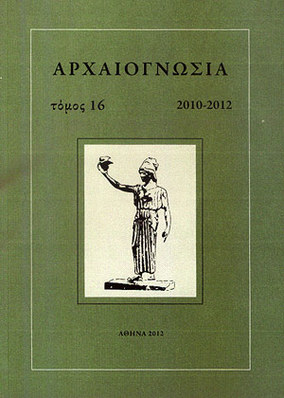Πεφυζότες ηΰτε νεβροί : αρχαιολογία και ποιητική εικονοποιία ενός Ομηρικού λογότυπου
Part of : Αρχαιογνωσία ; Vol.11, No.1-2, 2001, pages 113-132
Issue:
Pages:
113-132
Section Title:
Μελέτες-Articles
Author:
Abstract:
The expression πεφυζότες ήΰτε νεβροί constitutes a formula occupying the second hemistich of a dactylic hexameter verse, after the trochaic caesura. It forms part of a simile which is, in its turn, placed, even in one of its allomorphic attestations, within an equivalent thematic context; it therefore recalls both in the singer’s and the audiences mind the same latent denotations. This dictional and thematic material has acquired, during the long period of its shaping within the tradition, a context-free semantic aura which it preserved even after its entrance and incorporation in Iliadic epic diction.Therefore, the participle πεφυζότες points to the complementary pole of the formulaic pair it belongs to, namely the simile ήΰτε νεβροί, and the whole formula illuminates the full semantic range of a specific poetic imagery that discloses Homeric eschatological beliefs engraved in the fossilized diction of the Kunstsprache.In particular, the above formula is always placed in contexts connected with water, in the form of a river or the sea. Water has been associated with death via the metaphor of a sea travel, since the passage to Hades has been connected with a watery element (Acherousia lake, Kokytos river etc.). In Homeric eschatological myth-making, the world of the living is separated from the world of the dead by a river, which functions as a border, both literal and figurative, for the passage to Hades.Homeric eschatological beliefs are consonant with the latent association of the word πόντος (sea) with imminent danger. Indo-european evidence points (as Nagy has shown) to the same direction (see Indian pànthâh [path, passage] and latin pons [bridge]). So, the wider semantics of these three terms allude to the concept of transition and, in particular, of dangerous transition.It seems that the pre-verbal Gestalt which was nascent in the formula πεφυζότες ήΰτε νεβροί was that of the terrified, panic-stricken young deer being attacked by some carnivorous predator when they were drinking water. This preverbal Gestalt is in the singer’s mind who, in spite of his modification of the formulaic prototype, places the formula in a context associated with water, thus alluding to the initial imagery the simile originated from. The participles πεφυζότες and τεθηπότες determine the framework including two temporally distinct phases of the realization of the Gestalt, confusion and daze before the imminent menace (τεθηπότες) and panic-stricken flight (πεφυζότες). Thus, the πόντος notion expresses the concept of dangerous transition and the water imagery connotes destruction, imminent death.
Subject (LC):
Keywords:
αρχαία ελληνική επική ποίηση, Όμηρος




